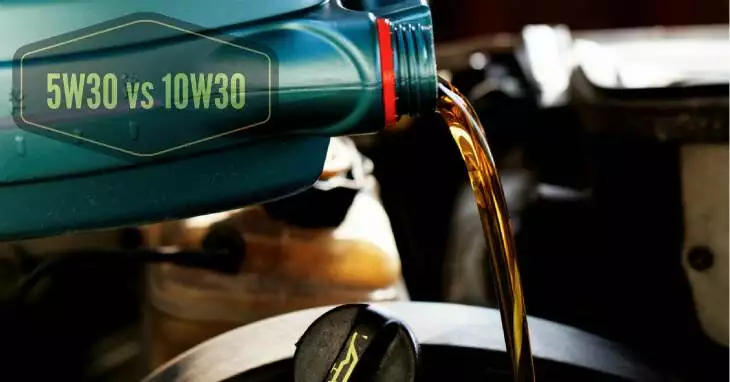A key consideration for engine care is selecting the right motor oil which will deliver the optimum results, in the form of reliable engine performance. Not all oil types will fit the vehicle and some may even impact the way the engine works. If you are more of a DIY person, who personally likes to take care of his own car, then knowing the right type of motor oil for your vehicle can be critical. Taking a stroll down the oil aisle will definitely overwhelm you, which is why we will be doing a thorough 5w30 vs 10w30 comparison since these two are the most common ones you will come across.
Read more about the difference between 5w30 vs 5w40.
More...
What Is Viscosity And Why Is It Important?

Motor oil is the lifeline of an engine and something that a lot of people take for granted. The assumption that oil is just used for lubricating, and not for enhancing the performance of a vehicle may prove to be wrong in the long run. If you really understand the basics of what oil does, what it is designed to do, and why it is important for the maintenance of your car, then you can go a long way in maximizing the health and lifespan of your vehicle.
The viscosity or thickness of motor oil determines its ability to flow well through the engine. The higher the first number, the thicker or more viscous the oil will be. The Society of Automotive Engineers (SAE) has assigned different statistical codes to different motor oils for the purpose of determining their viscosity. Thin liquids with a water-like consistency are assigned a lower viscosity value, while thick liquids with a honey-like consistency are assigned a higher value.
Therefore, if you live in a region where the temperature is usually very low or freezing, you should go for thin grade oil, such as 5w30. This is because they take much less time to heat up and are thus ready to flow through. On the other hand, thicker motor oils, such as 10w30, require more time before they are finally warmed up and are thus best suited for warmer environments. If you are not sure which viscosity is best suited to your vehicle, you can always refer to the top of the crankcase, which will have all the relevant information.
5w30 vs. 10W30 - What’s The Difference?

The first numerical, in this case, 5 and 10, are indicating how easy it is for the oil to flow through the engine at low temperatures. The lesser the number, the thinner the motor oil: 5 travels more smoothly and quicker than 10, a 10 better than 20, etc. A lower number indicates a lower viscosity, which means that the motor oil will offer faster protection to the engine’s internal components.
The second numerical, in this case, 30, is indicative of the oil’s thickness when it reaches high/operating temperatures. Thicker and high-viscosity oil will better adhere to mechanical parts when subjected to high stress and pressure and can resist higher temperatures before becoming thinner beyond its operational viscosity, which in simpler words means its ability to provide ample protection to the internal components.
When it comes to the difference between the two oils, it’ is their cold flowability. What this means is that a 10w30 will move much slower as compared to 5w30 motor during cold start-ups. However, at high temperatures, both motor oils will have the same level of viscosity, which is 30, and will travel through the engine and protect its parts in a similar manner.
If the motor oil will remain in the engine throughout the winter period and you live in a colder region, the recommended oil for you is 5w30. However, if it will remain in the engine during the warm summer months, then go for 10w30. Here are some of the important things to keep in mind:
- 5w30 motor oil is designed to function at ambient temperature, as low as -22 degrees Fahrenheit (-30 degrees Fahrenheit), making it an ideal choice if you live in colder climates, such as that of USA or Canada.
- You can also use 5w30 if you live in warm climates that go up to 95 degrees Fahrenheit or 35 degrees Celsius.
- In general, 5w30 is an ideal multi-grade oil that can be used in almost any temperature in both cold and warm climates.
On the other hand, 10w30 motor oil:
- Is an oil whose viscosity actually changes between cold and hot temperatures, due to special viscosity modifying additives in its formulation.
- Performs best at temperatures above 0 degrees Fahrenheit (-18 degrees Celsius) and below 86 degrees Fahrenheit and 30 degrees Celsius.
If you live in a colder environment, you will find that 10w30 motor oil flows much slower as compared to 5w30. This can both be of advantage and disadvantage. A more viscous oil, such as 10w30, will seal better than low viscosity oil, such as the 5w30. Thicker motor oil also offers better lubrication of key engine parts. However, thicker oils also put more drag on these engine parts, thus slowing down the engine performance. This excess resistance by motor oil can increase the consumption of fuel and also thus minimize fuel efficiency.
Takeaway
If you are unsure between 5w30 vs 10w30, we recommend that you go for 5w30 since it is a multigrade oil and can be used in both high and low temperatures. Furthermore, it is quite fuel-efficient since it doesn’t put an excess drag on the bearing and engine parts.
But if you have an old engine or are looking for a better sealing capability in motor oil, then definitely go for a 10w30 oil. This is because older engines experience more widened clearances and thus need a more viscous oil for enhanced protection.

thanks Jason very helpful,,,,,,,,,,,,,,,,,,,,,,,mike
My car is Corolla 2010,with 40000km. I am in Karachi Pakistan where the normal summer temperatures are from 30/35C.Which engine oil do you recomend? 5w30 or 10w40.Lately I’m using 10w40 Castrol oil. Thanks.
How does it matter- since you are going to blow the car in front of some consulate / school anyways.. use horse urine instead.